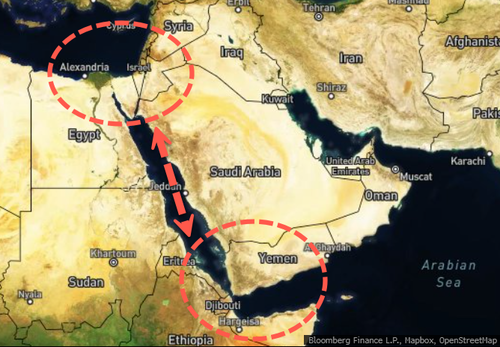Houthis Warn ‘No Red Lines’ In Counterattack After Israel Bombs Yemeni Port
Israel confirmed on Sunday its military forces launched a retaliatory airstrike on the Hodeida Port, a key Yemeni port on the Red Sea and the second largest in the country.
Al Hudaydah port in Yemen keeps burning and all their oil reserves are going up in flames, more than 24 hours after Israel’s bombing 👇
They shouldn’t have sent that f*cking drone to Tel Aviv.
pic.twitter.com/V3Zt8yFoy3
— Dr. Eli David (@DrEliDavid) July 21, 2024
Israel’s Prime Minister Benjamin Netanyahu said the Hodeida port was the “entry point for weapons that Iran supplies to its Houthi terrorist proxies. The Houthis have used those weapons to attack Israel, to attack Arab states in the region, to attack many others.”
From the beginning of the war, I made it clear that Israel will act against all attackers, which is why we struck Houthi targets in Yemen yesterday in response to the deadly drone attack near the US Consulate in Tel Aviv.
The targeted port is used for smuggling weapons from Iran… pic.twitter.com/7mO6s5dVGB
— Benjamin Netanyahu – בנימין נתניהו (@netanyahu) July 21, 2024
Emanuel Fabian, a military correspondent for The Times of Israel, posted on X satellite images from Israeli intelligence and imagery firm ImageSat that show extensive damage at the Hodeida port.
The Israeli strike came one day after Iran-backed Houthis hit Tel Aviv with a drone for the first time, killing one person and injuring several others.
PM Netanyahu described the counteroffensive against Houthis as a “direct response” to the kamikaze drone attack on civilians in Tel Aviv.
Tonight Iran 🇮🇷 targeted the American 🇺🇲 embassy in Tel Aviv, and the drone missed it by one hundred feet.
Biden’s weakness is eroding all deterrence in the region. pic.twitter.com/KLQ9eAFQj5
— Dr. Eli David (@DrEliDavid) July 19, 2024
In response to the port attack, which killed three people and wounded 80, rebel spokesperson Mohammed Abdulsalam told Qatar’s Al Jazeera TV, who was cited by Times of Israel and Reuters staff, as saying there will be “no red lines” in the next attack on Israel.
“All sensitive institutions with all its levels will be a target for us,” Abdulsalam told Al Jazeera.
Separately, Houthi military spokesperson Yahya Saree warned the terror group’s “response to the Israeli aggression against our country is inevitably coming and will be huge.”
Over the last nine months, rebel forces have fired over 220 ballistic missiles, cruise missiles, and drones at Israel in support of Gaza, where Israel has been fighting Hamas terrorists.
Houthis have also targeted Western-linked vessels, including container ships and crude tankers, in the critical maritime chokepoint of the southern Red Sea and Gulf of Aden.
What’s clear is that Houthi’s threat coverage is expanding, something we told readers was possible at the start of May.
Numerous maritime chokepoints in the Middle East are under constant threat, which has only sparked a global supply shock (read: “Supply Shock: Shipping Container Costs Top $10,000 Amid Red Sea Turmoil Thinning Global Capacity”).
A recent note by David Asher, a senior fellow at the Hudson Institute and former State Department official in the Trump administration, warned that the next financial shock could potentially originate from the Middle East through the weaponization of crude oil by Iran.
On slide 29 of the report, Asher pointed out that Yemen’s Houthi rebels could begin targeting high-value oil facilities in Saudi Arabia. This would send Brent crude over the $100/bbl level quickly if Abqaiq were hit.
Remember 2019?
Israeli’s attack on Hodeida is a ‘message’ to Iran. Now, the perfect storm of escalation is possibly ahead.
All eyes are also on Brent crude prices.
Tyler Durden
Sun, 07/21/2024 – 14:45

